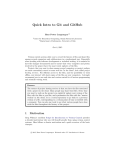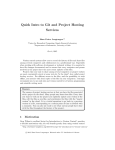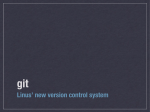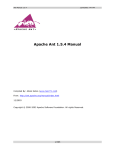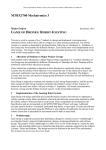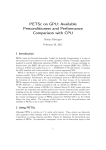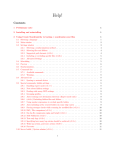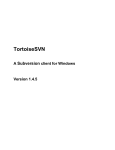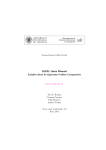Download Quick Intro to Git and Project Hosting Services
Transcript
Quick Intro to Git and Project Hosting Services Hans Petter Langtangen1,2 1 Center for Biomedical Computing, Simula Research Laboratory 2 Deptartment of Informatics, University of Oslo Oct 4, 2015 Version control systems allow you to record the history of files and share files among several computers and collaborators in a professional way. Especially when working with software development or technical writing, it is essential to have file changes documented and to ensure that every computer and person involved in the project have the most recent updates of the files. Projects that you want to share among several computers or project workers are most conveniently stored at some web site "in the cloud", here called project hosting services. For efficient access to the files, and the possibility to work offline, you interact with local copies of the files on your computers. I strongly recommend you to use such sites and version control for all serious programming and scientific writing work. Essence. The essence of project hosting services is that you have the files associated with a project in the cloud. Many people may share these files. Every time you want to work on the project you explicitly update your version of the files, edit the files as you like, and synchronize the files with the "master version" in the cloud. It is a trivial operation to go back to a previous version of a file, corresponding to a certain point of time or labeled with a comment. You can also use tools to see what various people have done with the files throughout the history of the project. 1 Motivation Greg Wilson’s excellent Script for Introduction to Version Control provides a detailed motivation why you will benefit greatly from using version control systems. Here follows a shorter motivation and a quick overview of the basic concepts. c 2015, Hans Petter Langtangen. Released under CC Attribution 4.0 license 1.1 Why not Dropbox or Google Drive? The simplest services for hosting project files are Dropbox and Google Drive. It is very easy to get started with these systems, and they allow you to share files among laptops and mobile units with as many users as you want. The systems offer a kind of version control in that the files are stored frequently (several times per minute), and you can go back to previous versions for the last 30 days. However, it is challenging to find the right version from the past when there are so many of them and when the different versions are not annotated with sensible comments. Another deficiency of Dropbox and Google Drive is that they sync all your files in a folder, a feature you clearly do not want if there are many large files (simulation data, visualizations, movies, binaries from compilations, temporary scratch files, automatically generated copies) that can easily be regenerated. However, the most serious problem with Dropbox and Google Drive arises when several people edit files simultaneously: it can be difficult detect who did what when, roll back to previous versions, and to manually merge the edits when these are incompatible. Then one needs more sophisticated tools, which means a true version control system. The following text aims at providing you with the minimum information to started with Git, the leading version control system, combined with project hosting services for file storage. 1.2 Repositories and local copies The mentioned services host all your files in a specific project in what is known as a repository, or repo for short. When a copy of the files are wanted on a certain computer, one clones the repository on that computer. This creates a local copy of the files. Now files can be edited, new ones can be added, and files can be deleted. These changes are then brought back to the repository. If users at different computers synchronize their files frequently with the repository, most modern version control systems will be able to merge changes in files that have been edited simultaneously on different computers. This is perhaps one of the most useful features of project hosting services. However, the merge functionality clearly works best for pure text files and less well for binary files, such as PDF files, MS Word or Excel documents, and OpenOffice documents. 1.3 Installing Git The installation of Git on various systems is described on the Git website under the Download section. Git involves compiled code so it is most convenient to download a precompiled binary version of the software on Windows, Mac and other Linux computers. On Ubuntu or any Debian-based system the relevant installation command is Terminal> sudo apt-get install git gitk git-doc c 2015, Hans Petter Langtangen. Released under CC Attribution 4.0 license 2 This tutorial explains Git interaction through command-line applications in a terminal window. There are numerous graphical user interfaces to Git. Three examples are git-cola, TortoiseGit, and SourceTree. 1.4 Configuring Git Make a file .gitconfig in your home directory with information on your full name, email address, your favorite text editor, and the name of an “excludes file” which defines the file types that Git should omit when bringing new directories under version control. Here is a simplified version of the author’s .gitconfig file: [user] name = Hans Petter Langtangen email = [email protected] editor = emacs [core] excludesfile = ~/.gitignore The “excludes file” is called .gitignore and must list, using the Unix Shell Wildcard notation, the type of files that you do not need to have under version control, because they represent garbage or temporary information, or they can easily be regenerated from some other source files. A suggested .gitignore file looks like # compiled files: *.o *.so *.a # temporary files: *.bak *.swp *~ .*~ *.old tmp* temp* .#* \#* # tex files: *.log *.dvi *.aux *.blg *.idx *.nav *.out *.toc *.snm *.vrb # eclipse files: *.cproject *.project # misc: .DS_Store c 2015, Hans Petter Langtangen. Released under CC Attribution 4.0 license 3 Be critical to what kind of files you really need a full history of. For example, you do not want to populate the repository with big graphics files of the type that can easily be regenerated by some program. 2 GitHub Go to github.com and create an account. Then go to your account settings (icon in the upper left corner of the page), choose SSH Keys, and provide your SSH key unless you have already registered this key with another GitHub account (see Appendix A). Often, it is just a matter of pasting the contents of id_rsa.pub or id_dsa.pub files, located in the .ssh subdirectory of your home directory, into the Key box in the web page. Make sure to just cut and paste the text from, e.g., id_rsa.pub without any extra whitespaces or other text. How to generate these files is described in the link generating SSH keys above the SSH Keys box. If the account is a project account and not a personal account, I do not recommend to provide an SSH key although it can be done (see Appendix A). It is easier to log in and add collaborators using their personal GitHub usernames. 2.1 Creating a new project Click on New repository on the main page and fill out a project name, here My Project, click the check button Initialize this repository with a README, and click on Create repository. Unless you pay, all repos are public, but students and teachers can request free, private repos. The next step is to clone the project on your personal computer. Click on the SSH button to see the address of the project, and paste this address into a terminal window, after git clone: Terminal> git clone git://github.com:user/My-Project.git Make sure you substitute user by your own username on GitHub. The result of the git clone command is a new directory My-Project. It contains the file .git, which shows that it is a Git repository. It also contains a default README.md file with the project name and description. The extension .md signifies a file written in the Markdown format. You may use the reStructuredText format as an alternative (README.rst), or simply write a plain text file (README), but the git mv command must be used to change the filename. You can now add files and directories into the My-Project directory. When your initial file collection has the desired form, you must run Terminal> git add . Terminal> git commit -am ’First set of files.’ Terminal> git push -u origin master The daily file operations are explained in Section 3. c 2015, Hans Petter Langtangen. Released under CC Attribution 4.0 license 4 Collaborating. To give others permissions to push their edits of files to the repository, you click on the Settings link in the right sidebar, then click on Collaborators on the left, and fill in the name of a collaborator (her or his username on GitHub). Many find it convenient to be notified in email when others have pushed a new version of the files to the repo. Click on Service Hooks in the project’s Settings menu, choose Email, fill in at most two whitespaceseparated email addresses, mark the Send from Author and Active boxes, and click on Update Settings. More addresses must be dealt with through a mailing list and filling in the name of that list. Anyone who participates in a project (has write access) or watches a project (having clicked the watch button) can monitor the development of the activity on their GitHub main page. Go to Account Settings and choose Notification Center. There you see two sections, Participating and Watching, for those participating in the project (granted write access) and those watching the project (having clicked the watch button), respectively. 2.2 Wiki pages With every GitHub project there is an option to create wiki pages. Click on the Wiki button in the right sidebar on the main page of the project. Click on New Page to create a new page. The wiki pages can be written in different markup languages. Markdown is the default choice, but you can alternatively use MediaWiki and reStructuredText. Unfortunately, GitHub wiki pages do not allow LATEX mathematics through MathJax, even though MediaWiki has support for LATEX (the reason is security issues). The wiki pages can be written and maintained through the web browser interface, but it is usually more convenient to clone them on your computer as this makes it easy to add figures and other documents you may want to link to. It also makes it straightforward to edit the wiki text in your favorite text editor. The wiki pages are stored in a separate repo and can be cloned by Terminal> git clone git://github.com/user/My-Project.wiki.git This command makes a local copy of the pages in the directory My-Project.wiki, which you may prefer to have at the same level as the project directory itself in your directory tree. Each wiki page has its own file, where the extension reflects the markup language used, e.g., .md for Markdown, .rest for reStructuredText, .mediawiki for MediaWiki, and .creole for Creole wiki. The wiki files are handled as other files in a GitHub project, i.e., you need to pull before editing and then perform commit and push. After the push you can reload the page in the web browser to monitor the effect. You may consider having the original text in doconce format and generate the wiki in the reStructuredText or MediaWiki format. Do changes, commit the usual way, and push by Terminal> git push [email protected]:user/My-project.wiki.git c 2015, Hans Petter Langtangen. Released under CC Attribution 4.0 license 5 The address can be stored as url in .git/config in the root directory of the wiki project so that just a standard git push works. 2.3 Project web pages HTML pages stored in your repo cannot be linked to and properly rendered as web pages. Say you have some HTML file doc/file.html in the repo. The normal link to the file is https://github.com/user/my-project/blob/master/doc/file.html which shows up as a nicely typeset, colorful HTML code. The raw text file, https://raw.githubusercontent.com/user/my-project/master/doc/file.html shows up as pure text in a browser. If one wants to see the file rendered as HTML code, one can view it through htmlpreview.github.io. This means that one can use the link http://htmlpreview.github.io/?https://raw.githubusercontent.com/user/my-project/master/doc/file.html to produce the HTML document in a browser. However, there is another technique available where all HTML files in a special branch gh-pages of the repository are automatically rendered correctly as HTML documents in a browser. This is the recommended technique for publishing a collection of HTML files related to the project in a simple and convenient way. The recipe is described in detail below. 1. Go to the project page on github.com and click Settings. 2. Click on Automatic Page Generator under the GitHub Pages. 3. Proceed clicking Continue to Layouts, choose a design of the index.html page that GitHub will create for you, and click Publish. 4. Go to the root directory of the project, My-Project and run git fetch origin. 5. Run git checkout gh-pages. You have now a new branch called gh-pages of your project containing an index.html file and directories for JavaScript programs and CSS style sheets in the root directory. The gh-pages branch will also all files not contained in the master branch, typically redundant files you have generated and which should not be stored in the version control system (remove these manually with git rm). You can populate the root directory and subdirectories of your gh-pages branch with HTML and other files as you like. The key issue is that the people out there will only see the web pages that correspond to your HTML files in the gh-pages branch! The index.html page is invoked by the web address c 2015, Hans Petter Langtangen. Released under CC Attribution 4.0 license 6 http://user.github.io/My-Project/index.html where user is the GitHub username and My-Project is the project name. The web pages and project files are now in two different branches. To see the branches, type git branch, and the one you are in will be marked with * in the output. Switching to the master branch is done by git checkout master. Similarly, git checkout gh-pages switches to the gh-pages branch. My personal preference is to have the master and gh-pages synchronized, at least in projects where I want to link to various source code files or other files from the web documentation. Sometimes I also update files in the gh-pages branch without remembering to switch to the master branch. To this end, one needs to merge the branches, i.e., automatically edit files in the current branch such that they are up-to-date and identical to files in another branch. To merge the current branch with some branch named otherbranch, run Terminal> git merge otherbranch Git applies smart algorithms that very often manage to merge the files without human interaction. However, occasionally these algorithms are not able to resolve conflicts between two files. A message about the failure of the merge is seen in the terminal window, and the corresponding files have markers in them showing which sections that needs manual editing to resolve the conflicts. Run git diff to show the problems (you can tailor this command to your needs as explained in Section 3.4). After a manual edit, do git commit -a. More details on merging appears in Section 3.2. If you want to keep the master branch and the gh-pages branch synchronized, start with merging the gh-pages branch with the master branch and push the complete file collection to the gh-pages branch. Then switch to the master branch and merge with gh-pages so you get the autogenerated index.html file and associated files and directories for web pages in the root directory of the master branch as well: Terminal> Terminal> Terminal> Terminal> Terminal> git merge master touch .nojekyll git push origin gh-pages git checkout master git merge gh-pages You must add an empty file .nojekyll in the top directory of the project pages if you want to use Sphinx-generated HTML pages (or other pages using javascripts, style sheets, and images in subdirectories whose names start with an underscore). You can now add the documentation to the project files and maintain them in the master branch. Before publishing documents online, make sure to update the gh-pages branch by Terminal> Terminal> Terminal> Terminal> Terminal> Terminal> Terminal> git git git git git git git commit -am ’Ensure commit of master branch’ push origin master checkout gh-pages pull origin gh-pages merge master push origin gh-pages checkout master c 2015, Hans Petter Langtangen. Released under CC Attribution 4.0 license 7 Personally, I like to move the generated index.html file and all associated scripts, stylesheets, and images from the root directory to some more isolated place, say doc/web: Terminal> git mv index.html params.json stylesheets/ images/ \ javascripts/ doc/web/ The URL of the index.html file is http://user.github.io/My-Project/doc/web/index.html Linking to source code files or other files in the project is easy: just find the file in GitHub’s web interface, choose which version of the file you want to link to (nicely HTML formatted version or the raw file), right-click on the link, choose Copy Link, and paste the link into the document you want. You can test that the link works by the Unix command curl -O <link>. Note that the link to a file is different from the source file’s intuitive path in the repository. Typically, a source file dir/f.py in project prj is reached through https://github.com/user/prj/blob/master/dir/f.py?raw=true Sometimes you want to link to another HTML file, PDF file, movie file, or a file that is to be interpreted as a web resource by the browser. Do not use the path to the file in the repo as explained above as it will just bring the reader to the repo page. Instead, make sure the file is in the gh-pages branch and use a local link, like ../doc.pdf, or the complete gh-pages URL to the file, say http://user.github.com/My-Project/doc/misc/doc.pdf Tip. The ordinary GitHub URL of image files can be used in web pages to insert images from your repo, provided the image files are in the raw format - click the Raw button when viewing a file at github.com and use the corresponding URL in the img tag in the HTML code. 2.4 User web pages GitHub also allows you to create user pages and organization pages not tied to any specific project. Your personal site has address http://user.github.com. Go to your home page on github.com and click New repository, and give it the project name user.github.com. Then follow the instructions that come up: Terminal> Terminal> Terminal> Terminal> Terminal> Terminal> Terminal> mkdir user.github.com cd user.github.com git init # make an index.html file with some test text git add index.html git commit -m ’First commit’ git remote add origin \ [email protected]:user/user.github.com.git Terminal> git push -u origin master c 2015, Hans Petter Langtangen. Released under CC Attribution 4.0 license 8 Go to http://user.github.com and see how the index.html is rendered. You can now add various contents as in any ordinary Git repository. If you want to use Sphinx generated HTML pages, recall to add an empty file .nojekyll. 3 Using Git Most Mac and Linux users prefer to work with Git via commands in a terminal window. Windows users may prefer a graphical user interface (GUI), and there are many options in this respect. There are also GUIs for Mac users. Here we concentrate on the efficient command-line interface to Git. 3.1 Basic Git commands Cloning. You get started with your project on a new machine, or another user can get started with the project, by running Terminal> git clone [email protected]:user/My-Project.git Terminal> cd My-Project ls Recall to replace user by your real username and My-Project by the actual project name. The pull-change-push cycle. The typical work flow with the "My Project" project starts with updating the local repository by going to the My-Project directory and writing Terminal> git pull origin master You may want to do git fetch and git merge instead of git pull as explained in Section 3.4, especially if you work with branches. You can now edit files, make new files, and make new directories. New files and directories must be added with git add. There are also Git commands for deleting, renaming, and moving files. Typical examples on these Git commands are Terminal> Terminal> Terminal> Terminal> Terminal> git git git git git add file2.* dir1 dir2 rm file3 rm -r dir2 mv oldname newname mv oldname ../newdir # add files and directories When your chunk of work is ready, it is time to commit your changes (note the -am option): Terminal> git commit -am ’Description of changes.’ If typos or errors enter the message, the git commit –amend command can be used to reformulate the message. Running git diff prior to git commit makes it easier to formulate descriptive commit messages since this command gives a c 2015, Hans Petter Langtangen. Released under CC Attribution 4.0 license 9 listing of all the changes you have made to the files since the last commit or pull command. You may perform many commits (to keep track of small changes), before you push your changes to the global repository: Terminal> git push origin master Do pull and push often! It is recommended to pull, commit, and push frequently if the work takes place in several clones of the repo (i.e., there are many users or you work with the repo on different computers). Infrequent push and pull easily leads to merge problems (see Section 3.2). Also remember that others (human and machines) cannot get your changes before they are pushed! Do not forget to add important files. You should run git status -s frequently to see the status of files: A for added, M for modified, R for renamed, and ?? for not being registered in the repo. Pay particular attention to the ?? files and examine if all of them are redundant or easily regenerated from other files - of not, run git add. Make sure you have a .gitignore file. The simplest way of adding files to the repo is to do Terminal> git add . The dot adds every file, and this is seldom what you want, since your directories frequently contain large redundant files or files that can easily be regenerated. You therefore need a .gitignore file, see Section 1.4, either in your home directory or in the root directory of the repo. The .gitignore file will ignore undesired files when you do git add .. Viewing the history of files. A nice graphical tool allows you to view all changes, or just the latest ones: Terminal> gitk --all Terminal> gitk --since="2 weeks ago" You can also view changes to all files, some selected ones, or a subdirectory: c 2015, Hans Petter Langtangen. Released under CC Attribution 4.0 license 10 Terminal> Terminal> Terminal> Terminal> git git git git log log log log -p # all changes to all files -p filename # changes to a specific file --stat --summary # compact summary --stat --summary subdir Adding –follow will print the history of file versions before the file got its present name. To show the author who is responsible for the last modification of each line in the file, use git blame: Terminal> git blame filename Terminal> git blame --since="1 week" filename A useful command to see the history of who did what, where individual edits of words are highlighted (–word-diff), is git log -p --stat --word-diff filename Removed words appear in brackets and added words in curly braces. Looking for when a particular piece of text entered or left the file, say the text def myfunc, one can run Terminal> git log -p --word-diff --stat -S’def myfunc’ filename This is useful to track down particular changes in the files to see when they occurred and who introduced them. One can also search for regular expressions instead of exact text: just replace -S by -G. Retrieving old files. Occasionally you need to go back to an earlier version of a file, e.g., a file called f.py. Start with viewing the history: Terminal> git log f.py Find a commit candidate from the list that you will compare the present version to, copy the commit hash (string like c7673487...), and run Terminal> git diff c7673487763ec2bb374758fb8e7efefa12f16dea f.py where the long string is the relevant commit hash. You can now view the differences between the most recent version and the one in the commit you picked (see Section 3.4 for how to configure the tools used by the git diff command). If you want to restore the old file, write Terminal> git checkout c7673487763ec2bb374758fb8e7efefa12f16dea f.py To go back to another version (the most recent one, for instance), find the commit hash with git log f.py, and do get checkout <commit hash> f.py. If f.py changed name from e.py at some point and you want e.py back, run git log –follow f.py to find the commit when e.py existed, and do a git checkout <commit hash> e.py. In case f.py no longer exists, run git log – f.py to see its history before deletion. The last commit shown does not contain the file, so you need to check out the next last to retrieve the latest version of a deleted file. Often you just need to view the old file, not replace the current one by the old one, and then git show is handy. Unfortunately, it requires the full path from the root git directory: c 2015, Hans Petter Langtangen. Released under CC Attribution 4.0 license 11 Terminal> git show \ c7673487763ec2bb374758fb8e7efefa12f16dea:dir1/dir2/f.py Reset the entire repo to an old version. Run git log on some file and find the commit hash of the date or message when want to go back to. Run git checkout <commit hash> to change all files to this state. The problem of going back to the most recent state is that git log has no newer commits than the one you checked out. The trick is to say git checkout master to set all files to most recent version again. If you want to reset all files to an old version and commit this state as the valid present state, you do Terminal> git checkout c7673487763ec2bb374758fb8e7efefa12f16dea . Terminal> git commit -am ’Resetting to ...’ Note the period at the end of the first command (without it, you only get the possibility to look at old files, but the next commit is not affected). Going back to a previous commit. Sometimes accidents with many files happen and you want to go back to the last commit. Find the hash of the last commit and do Terminal> git reset --hard c867c487763ec2 This command destroys everything you have done since the last commit. To push it as the new state of the repo, do Terminal> git push origin HEAD --force 3.2 Merging files with Git The git pull command fetches new files from the repository and tries to perform an automatic merge if there are conflicts between the local files and the files in the repository. Alternatively, you may run git fetch and git merge to do the same thing as described in Section 3.4. We shall now address what do to if the merge goes wrong, which occasionally happens. Git will write a message in the terminal window if the merge is unsuccessful for one or more files. These files will have to be edited manually. Merge markers of the type »»>, ======, and ««< have been inserted by Git to mark sections of a file where the version in the repository differ from the local version. You must decide which lines that are to appear in the final, merged version. When done, perform git commit and the conflicts are resolved. Graphical merge tools may ease the process of merging text files. You can run git mergetool –tool=meld to open the merge tool meld for every file that needs to be merged (or specify the name of a particular file). Other popular merge tools supported by Git are araxis, bc3, diffuse, ecmerge, emerge, gvimdiff, kdiff3, opendiff, p4merge, tkdiff, tortoisemerge, vimdiff, and xxdiff. c 2015, Hans Petter Langtangen. Released under CC Attribution 4.0 license 12 Below is a Unix shell script illustrating how to make a global repository in Git, and how two users clone this repository and perform edits in parallel. There is one file myfile in the repository. # !/ bin / sh # Demo script for e x e m p l i f y i n g git and merge rm - rf tmp1 tmp2 tmp_repo # Clean up p r e v i o u s runs mkdir tmp_repo # Global r e p o s i t o r y for testing cd tmp_repo git -- bare init -- shared cd .. # Make a repo that can be pushed to t m p _ r e p o mkdir _tmp cd _tmp cat > myfile << EOF This is a little test file for exemplifying merge of files in different git directories . EOF git init git add . # Add all files not m e n t i o n e d in ~/. g i t i g n o r e git commit - am ’ first commit ’ git push ../ tmp_repo master cd .. rm - rf _tmp # Make a new hg r e p o s i t o r i e s tmp1 and tmp2 ( two users ) git clone tmp_repo tmp1 git clone tmp_repo tmp2 # Change myfile in the d i r e c t o r y tmp1 cd tmp1 # Edit myfile : insert a new second line perl - pi -e ’s / a little \ n / a little \ ntmp1 - add1 \ n /g ’ myfile # R e g i s t e r change in local r e p o s i t o r y git commit - am ’ Inserted a new second line in myfile . ’ # Look at changes in this clone git log -p # or a more compact summary git log -- stat -- summary # or g r a p h i c a l l y # gitk # R e g i s t e r change in global r e p o s i t o r y t m p _ r e p o git push origin master cd .. # Change myfile in the d i r e c t o r y tmp2 " in p a r a l l e l " cd tmp2 # Edit myfile : add a line at the end cat >> myfile << EOF tmp2 - add1 EOF # R e g i s t e r change locally c 2015, Hans Petter Langtangen. Released under CC Attribution 4.0 license 13 git commit - am ’ Added a new line at the end ’ # R e g i s t e r change g l o b a l l y git push origin master # Error message : global r e p o s i t o r y has changed , # we need to pull those changes to local r e p o s i t o r y first # and see if all files are c o m p a t i b l e before we can update # our own changes to the global r e p o s i t o r y . # git writes # To / home / hpl / vc / s c r i p t i n g / manu / py / bitgit / src - bitgit / t m p _ r e p o # ! [ rejected ] master -> master ( non - fast - forward ) # error : failed to push some refs to ... git pull origin master # git writes : # Auto - merging myfile # Merge made by r e c u r s i v e . # myfile | 1 + # 1 files changed , 1 i n s e r t i o n s (+) , 0 d e l e t i o n s ( -) cat myfile # s u c c e s s f u l merge ! git commit - am merge git push origin master cd .. # Perform new changes in p a r a l l e l in tmp1 and tmp2 , # this time causing hg merge to fail # Change myfile in the d i r e c t o r y tmp1 cd tmp1 # Do it all right by pulling and u p d a t i n g first git pull origin master # Edit myfile : insert " just " in first line . perl - pi -e ’s / a little / tmp1 - add2 a little /g ’ myfile # R e g i s t e r change in local r e p o s i t o r y git commit - am ’ Inserted " just " in first line . ’ # R e g i s t e r change in global r e p o s i t o r y t m p _ r e p o git push origin master cd .. # Change myfile in the d i r e c t o r y tmp2 " in p a r a l l e l " cd tmp2 # Edit myfile : replace little by modest perl - pi -e ’s / a little / a tmp2 - replace1 \ ntmp2 - add2 \ n /g ’ myfile # R e g i s t e r change locally git commit - am ’ Replaced " little " by " modest " ’ # R e g i s t e r change g l o b a l l y git push origin master # Not p o s s i b l e : need to pull changes in the global r e p o s i t o r y git pull origin master # git writes # C O N F L I C T ( content ) : Merge c o n f l i c t in myfile # A u t o m a t i c merge failed ; fix c o n f l i c t s and then commit the result . # we have to do a manual merge cat myfile echo ’ Now you must edit myfile manually ’ c 2015, Hans Petter Langtangen. Released under CC Attribution 4.0 license 14 You may run this file git_merge.sh named by sh -x git_merge.sh. At the end, the versions of myfile in the repository and the tmp2 directory are in conflict. Git tried to merge the two versions, but failed. Merge markers are left in tmp2/myfile: <<<<<<< HEAD This is a tmp2-replace1 tmp2-add2 ======= This is tmp1-add2 a little >>>>>>> ad9b9f631c4cc586ea951390d9415ac83bcc9c01 tmp1-add1 test file for exemplifying merge of files in different git directories. tmp2-add1 Launch a text editor and edit the file, or use git mergetool, so that the file becomes correct. Then run git commit -am merge to finalize the merge. 3.3 Git working style with branching and stashing Branching and stashing are nice features of Git that allow you to try out new things without affecting the stable version of your files. Usually, you extend and modify files quite often and perform a git commit every time you want to record the changes in your local repository. Imagine that you want to correct a set of errors in some files and push these corrections immediately. The problem is that such a push will also include the latest, yet unfinished files that you have committed. Branching. A better organization of your work would be to keep the latest, ongoing developments separate from the more official and stable version of the files. This is easily achieved by creating a separate branch where new developments takes place: Terminal> Terminal> Terminal> Terminal> Terminal> Terminal> Terminal> Terminal> Terminal> Terminal> Terminal> git branch newstuff # create new branch git checkout newstuff # extend and modify files... git commit -am ’Modified ... Added a file on ...’ git checkout master # swith back to master # correct errors git push origin master git checkout newstuff # switch to other branch git merge master # keep branch up-to-date w/master # continue development work... git commit -am ’More modifications of ...’ At some point, your developments in newstuff are mature enough to be incorporated in the master branch: Terminal> Terminal> Terminal> Terminal> git git git git checkout newstuff merge master checkout master merge newstuff # synchronize newstuff w/master # synchronize master w/newstuff c 2015, Hans Petter Langtangen. Released under CC Attribution 4.0 license 15 You no longer need the newstuff branch and can delete it: Terminal> git branch -d newstuff This command deletes the branch locally. To also delete the branch in the remote repo, run Terminal> git push origin --delete newstuff You can learn more in an excellent introduction and demonstration of Git branching. Stashing. It is not possible to switch branches unless you have committed the files in the current branch. If your work on some files is in a mess and you want to change to another branch or fix other files in the current branch, a “global” commit affecting all files might be immature. Then the gitstash command is handy. It records the state of your files and sets you back to the state of the last commit in the current branch. With git stash apply you will update the files in this branch to the state when you did the last git stash. Let us explain a typical case. Suppose you have performed some extensive edits in some files and then you are suddenly interrupted. You need to fix some typos in some other files, commit the changes, and push. The problem is that many files are in an unfinished state - in hindsight you realize that those files should have been modified in a separate branch. It is not too late to create that branch! First run git stash to get the files back to the state they were at the last commit. Then run git stash branch newstuff to create a new branch newstuff containing the state of the files when you did the (last) git stash command. Stashing used this way is a convenient technique to move some immature edits after the last commit out in a new branch for further experimental work. Warning. You can get the stashed files back by git stash apply. It is possible to multiple git stash and git stash apply commands. However, it is easy to run into trouble with multiple stashes, especially if they occur in multiple branches, as it becomes difficult to recognize which stashes that belong to which branch. A good advice is therefore to do git stash only once to get back to a clean state and then move the unfinished messy files to a separate branch with git stash branch newstuff. 3.4 Replacing pull by fetch and merge The git pull command actually performs two steps that are sometimes advantageous to run separately. First, a get fetch is run to fetch new files from the c 2015, Hans Petter Langtangen. Released under CC Attribution 4.0 license 16 repository, and thereafter a git merge command is run to merge the new files with your local version of the files. While git pull tries to do a lot and be smart in the merge, very often with success, the merge step may occasionally lead to trouble. That is why it is recommended to run a git merge separately, especially if you work with branches. To fetch files from your repository at GitHub, which usually has the nickname origin, you write Terminal> git fetch origin You now have the possibility to check out in detail what the differences are between the new files and local ones: Terminal> git diff origin/master This command produces comparisons of the files in the current local branch and the master branch at origin (the GitHub repo). In this way you can exactly see the differences between branches. It also gives you an overview of what others have done with the files. When you are ready to merge in the new files from the master branch of origin with the files in the current local branch, you say Terminal> git merge origin/master Especially when you work with multiple branches, as outlined in Section 3.3, it is wise to first do a get fetch origin and then update each branch separately. The git fetch origin command will list the branches, e.g., * master gh-pages next After updating master as described, you can continue with another branch: Terminal> Terminal> Terminal> Terminal> git git git git checkout next diff origin/next merge origin/next checkout master Configuring the git diff command. The git diff command launches by default the Unix diff tool in the terminal window. Many users prefer to use other diff tools, and the desired one can be specified in your /.gitconfig file. However, a much recommended approach is to wrap a shell script around the call to the diff program, because git diff actually calls the diff program with a series of command-line arguments that will confuse diff programs that take the names of the two files to be compared as arguments. In /.gitconfig you specify a script to do the diff: [diff] external = ~/bin/git-diff-wrapper.sh It remains to write the git-diff-wrapper.sh script. The 2nd and 5th commandline arguments passed to this script are the name of the files to be compared in the diff. A typical script may therefore look like c 2015, Hans Petter Langtangen. Released under CC Attribution 4.0 license 17 # !/ bin / sh diff " $2 " " $5 " | less Here we use the standard (and quite primitive) Unix diff program, but we can replace diff by, e.g., diffuse, kdiff3, xxdiff, meld, pdiff, or others. With a Python script you can easily check for the extensions of the files and use different diff tools for different types of files, e.g., latexdiff for LATEX files and pdiff for pure text files. Replacing all your files with those in the repo. Occasionally it becomes desirable to replace all files in the local repo with those in the repo at the file hosting service. One possibility is removing your repo and cloning again, or use the Git commands Terminal> git fetch --all Terminal> git reset --hard origin/master Merging with just one file from another branch. Say you have two branches, A and B, and want to merge a file f.txt in A with the latest version in B. To merge this single file, go to the directory where f.txt resides and do Terminal> git checkout A Terminal> git checkout --patch B f.txt If f.txt is not present in branch A, and if you want to include more files, drop the –patch option and specify files with full path relative to the root in the repo: Terminal> git checkout A Terminal> git checkout B doc/f.txt src/files/g.py Now, f.txt and g.py from branch B will be included in branch A as well. 3.5 Team work with forking and pull requests In small collaboration teams it is natural that everyone has push access to the repo. On GitHub this is known as the Shared Repository Model. As teams grow larger, there will usually be a few people in charge who should approve changes to the files. Ordinary team members will in this case not clone a repo and push changes, but instead fork the repo and send pull requests, which constitutes the Fork and Pull Model. c 2015, Hans Petter Langtangen. Released under CC Attribution 4.0 license 18 Say you want to fork the repo https://github.com/somebody/proj1.git. The first step is to press the Fork button on the project page for the somebody/proj1 project on GitHub. This action creates a new repo proj1, known as the forked repo, on your GitHub account. Clone the fork as you clone any repo: Terminal> git clone https://github.com/user/proj1.git When you do git push origin master, you update your fork. However, the original repo is usually under development too, and you need to pull from that one to stay up to date. A git pull origin master pulls from origin which is your fork. To pull from the original repo, you create a name upstream, either by Terminal> git remote add upstream \ https://github.com/somebody/proj1.git if you cloned with such an https address, or by Terminal> git remote add upstream \ [email protected]:somebody/proj1.git if you cloned with a [email protected] (SSH) address. Doing a git pull upstream master would seem to be the command for pulling the most recent files in the original repo. However, it is not recommended to update the forked repo’s files this way because heavy development of the sombody/proj1 project may lead to serious merge problems. It is much better to replace the pull by a separate fetch and merge. The typical workflow is Terminal> Terminal> Terminal> Terminal> Terminal> git fetch upstream # get new version of files git merge upstream/master # merge with yours # Your files are up to date - ready for editing git commit -am ’Description...’ git push origin master # store changes in your fork At some point you would like to push your changes back to the original repo somebody/proj1. This is done by a pull request. Make sure you have selected the right branch on the project page of your forked project. Press the Pull Request button and fill out the form that pops up. Trusted people in the somebody/proj1 project will now review your changes and if they are approved, your files are merged into the original repo. If not, there are tools for keeping a dialog about how to proceed. Also in small teams where everyone has push access, the fork and pull request model is beneficial for reviewing files before the repo is actually updated with new contributions. 3.6 Cloning a repo with multiple branches An annoying feature of Git for beginners is the fact that if you clone a repo, you only get the master branch. There are seemingly no other branches: Terminal> git branch * master c 2015, Hans Petter Langtangen. Released under CC Attribution 4.0 license 19 To see which branches that exist in the repo, type Terminal> git branch -a * master remotes/origin/HEAD -> origin/master remotes/origin/gh-pages remotes/origin/master remotes/origin/next If there is only one remote repo that you pull/push from/to, you can simply switch branch with git checkout the usual way: Terminal> git Terminal> git * gh-pages master Terminal> git Terminal> git gh-pages master * next checkout gh-pages branch checkout next branch You might need to do git fetch origin to see new branches made on other machines. When you have more than one remote, which is usually the case if you have forked a repo, see Section 3.5, you must use do a checkout with specifying the remote branch you want: Terminal> git checkout -b gh-pages --track remote/gh-pages Terminal> git checkout -b next --track upstream/next Files can be edited, added, or removed as soon as you have done the local checkout. It is possible to write a little script that takes the output of git branch -a after a git clone command and automatically check out all branches via git checkout. 3.7 Git workflows Although the purpose of these notes is just to get the reader started with Git, it must be mentioned that there are advanced features of Git that have led to very powerful workflows with files and people, especially for software development. There is an official Git workflow model that outlines the basic principles, but it can be quite advanced for those with modest Git knowledge. A more detailed explanation of a recommended workflow for beginners is given in the developer instructions for the software package PETSc. This is highly suggested reading. The associated "quick summary" of Git commands for their workflow is also useful. 3.8 Git tips How can I see which files are tracked by Git? git ls-files is the command: c 2015, Hans Petter Langtangen. Released under CC Attribution 4.0 license 20 Terminal> Terminal> Terminal> Terminal> git git git git ls-files # list all tracked files ls-files -o # list non-tracked files ls-files myfile # prints myfile if it’s tracked ls-files myfile --error-unmatch The latter command prints an error message if myfile is not tracked. See man git-ls-files for the many options this utility has. How can I reduce the size of a repo? The command git gc can compress a git repository and should be run regularly on large repositories. Greater effect is achieved by git gc –aggressive –prune=all. You can measure the size of a repo before and after compression by git gc using du -s repodir, where repodir is the name of the root directory of the repository. Occasionally big or sensitive files are removed from the repo and you want to permanently remove these files from the revision history. This is achieved using gitfilter-branch. To remove a file or directory with path doc/src/mydoc relative to the root directory of the repo, go to this root directory, make sure all branches are checked out on your computer, and run Terminal> git filter-branch --index-filter \ ’git rm -r --cached --ignore-unmatch doc/src/mydoc’ \ --prune-empty -- --all Terminal> rm -rf .git/refs/original/ Terminal> git reflog expire --expire=now --all Terminal> git gc --aggressive --prune=now Terminal> git push origin master --force # do this for each branch Terminal> git checkout somebranch Terminal> git push origin somebranch --force You must repeat the push command for each branch as indicated. If other users have created their own branches in this repo, they need to rebase, not merge, when updating the branches! How can I restore missing files? Sometimes you accidentally remove files from a repo, either by git rm or a plain rm. You can get the files back as long as they are in the remote repo. In case of a plain rm command, run Terminal> git checkout ‘git ls-files‘ to restore all missing files in the current directory. In case of a git rm command, use git log –diff-filter=D –summary to find the commit hash corresponding to the last commit the files were in the repo. Restoring a file is then done by Terminal> git checkout <commit hash> filename 3.9 More documentation on Git • Git - the simple guide • Web course on Git c 2015, Hans Petter Langtangen. Released under CC Attribution 4.0 license 21 • Everyday GIT With 20 Commands Or So • Git cheat sheet • Atlassian Git Tutorials • Atlassian Git Workflows • GitHub Guides: – Getting your project on GitHub – Repositories, branches, commits, issues, and pull requests – GitHub (web) pages – Understanding the GitHub Flow • Git branching • Git top 10 tutorials • Lars Vogel’s Git Tutorial • How to use Git with Dropbox • Git Community Book (explains Git very well) • Git for Designers (aimed a people with no previous knowledge of version control systems) • Git Magic: Basic Tricks • The official Git Tutorial • Git Tutorial Video on YouTube • Git Questions • Git Reference (can also be used as a tutorial on Git) • Git User Manual • Git home page • Quick intro to Git and GitHub (somewhat like the present guide) • Git/GitHub GUIs on Windows and Mac • 10 Things I hate about Git c 2015, Hans Petter Langtangen. Released under CC Attribution 4.0 license 22 A Working with multiple GitHub accounts Working against different GitHub accounts is easy if each project you work with on each account adds you as a collaborator. The term "you" here means your primary username on GitHub. My strong recommendation is to always check out a project using your primary GitHub username. Occasionally you want to create a new GitHub account, say for a project XYZ. For such a non-personal account, do not provide an SSH key of any particular user. The reason is that this user will then get two GitHub identities, and switching between these identities will require some special tweakings. Just forget about the SSH key for a project account and add collaborators to repos using each collaborators personal GitHub username. If you really need to operate the XYZ account as a personal account, you must provide an SSH key that is different from any other key at any other GitHub account (you will get an error message if you try to register an already registered SSH key, but it is possible to get around the error message by providing an id_rsa.pub key on one account and an id_dsa.pub on another - that will cause trouble). Jeffrey Way has written a recipe for how to operate multiple GitHub accounts using multiple identities. To debug which identity that is used when you pull and push to GitHub accounts, you can first run Terminal> ssh -Tv [email protected] to see your current identity and which SSH key that was used to identify you. Typing Terminal> ssh-add -l lists all your SSH keys. The shown strings can be compared with the string in the SSH key field of any GitHub account. c 2015, Hans Petter Langtangen. Released under CC Attribution 4.0 license 23























